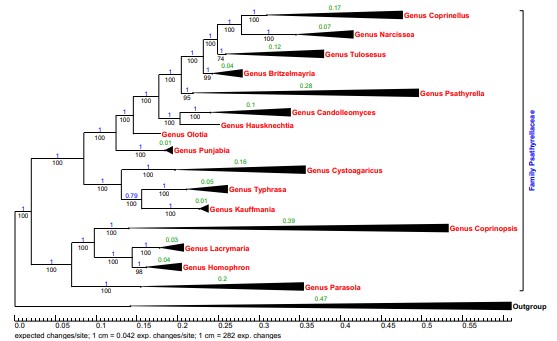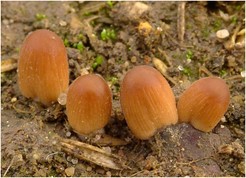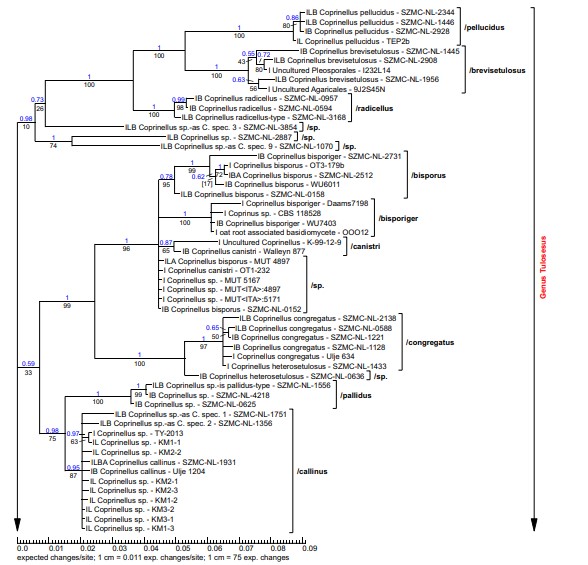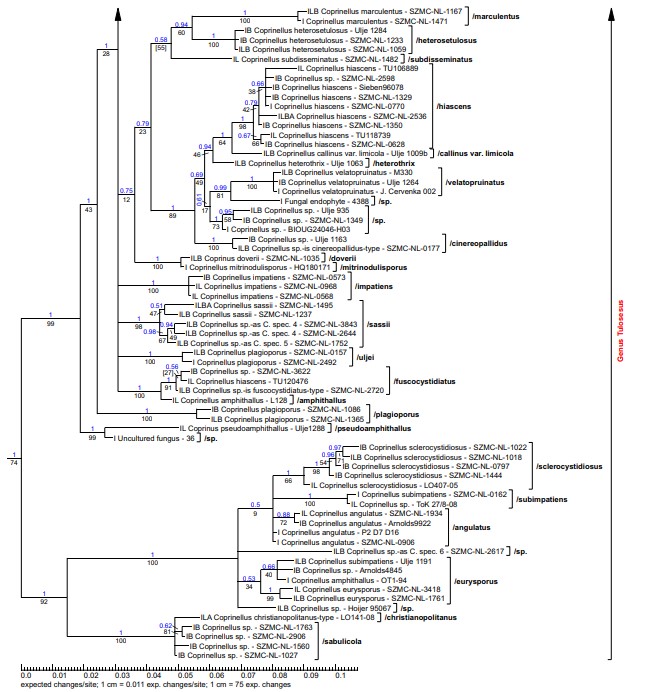Tulosesus Wächter & A. Melzer, gen. nov.(Fig. 59)
Index Fungorum number: MB 831799; Facesoffungi number: FoF
Etymology: The name is an anagram of Setulosus (see remarks).
Description: Basidiomata tiny to medium-sized, terrestri- al, lignicolous, subfimicolous or fimicolous. Lamellae deli- quescent or withering. Veil absent or present, if present consisting of chains of diverticulate, subcylindrical cells, sometimes also mixed with subglobose, occasionally encrusted elements, if so then spores with a polygonal outline. Spores mostly large-sized, occasionally medium-sized, rarely small, germ pore predominantly eccentric, rarely central. Basidia mostly 4-spored. Marginal cells of the lamellar edge very often clavate and sphaeropedunculate, sometimes mixed with lageniform cystidia, rarely purely lageniform. Pleurocystidia present or absent. Pileocystidia always present, often (sub-) capitate, sclerocystidia often present. Clamps present or absent.
Type species: Tulosesus callinus (M. Lange & A.H. Sm.) Wächter & A. Melzer (see Fig. 58).
Representatives:
Coprinellus amphithallus (M. Lange & A.H. Sm.) Redhead, Vilgalys & Moncalvo; Ref.v.: L128 (Nagy et al. 2012)
Coprinellus angulatus (Peck) Redhead, Vilgalys & Moncalvo; Ref.v.: SZMC-NL-0906 (Nagy et al. 2011)
Coprinellus bisporiger (Buller ex P.D. Orton) Redhead, Vilgalys & Moncalvo; Ref.v.: Daams7198 (Nagy et al. 2011)
Coprinellus bisporus (J.E. Lange) Vilgalys, Hopple & Jacq. Johnson; Ref.v.: SZMC-NL-0152 (Hazi et al. 2011)
Coprinellus brevisetulosus (Arnolds) Redhead, Vilgalys & Moncalvo; Ref.v.: SZMC-NL-1445 (Hazi et al. 2011)
Coprinellus callinus (M. Lange & A.H. Sm.) Vilgalys, Hopple & Jacq. Johnson; Ref.v.: SZMC-NL-1931 (Nagy, Walther et al. 2011)
Coprinellus canistri (Uljé & Verbeken) Doveri & Sarrocco; Ref.v.: Walleyn 877 (Nagy et al. 2012)
Coprinellus christianopolitanus Örstadius & E. Larss.; Ref.v.: LO141-08/type (Örstadius et al. 2015)
Coprinellus cinereopallidus L. Nagy, Házi, Papp & Vágvölgyi; Ref.v.: SZMC-NL-0177/type (Nagy et al. 2012)
Coprinellus congregatus P. Karst.; Ref.v.: SZMC-NL- 8588 (Hazi et al. 2011)
Coprinellus doverii (L. Nagy) Házi, L. Nagy, T. Papp & Vágvölgyi; Ref.v.: SZMC-NL-1035 (Nagy et al. 2012)
Coprinellus eurysporus (M. Lange & A.H. Sm.) Redhead, Vilgalys & Moncalvo; Ref.v.: Hoijer 95067 (Nagy et al. 2011) Coprinellus fuscocystidiatus L. Nagy, Házi, Papp & Vágvölgyi; Ref.v.: SZMC-NL-2720/type (Nagy et al. 2011). Coprinellus heterothrix (Kühner) Redhead, Vilgalys &
Moncalvo; Ref.v.: Ulje 1063 (Nagy et al. 2012)
Coprinellus hiascens (Fr.) Redhead, Vilgalys & Moncalvo; Ref.v.: SZMC-NL-1350 (Hazi et al. 2011)
Coprinellus impatiens (Fr.) J.E. Lange; Ref.v.: SZMC-NL- 1164 (Nagy et al. 2011)
Coprinellus marculentus (Britzelm.) Redhead, Vilgalys & Moncalvo; Ref.v.: SZMC-NL-1167 (Hazi et al. 2011)
Coprinellus mitrinodulisporus Doveri & Sarrocco; Ref.v.: HQ180171 (Doveri et al. 2010)
Coprinellus pallidus L. Nagy, Házi, Papp & Vágvölgyi; Ref.v.: SZMC-NL-1556/type (Nagy et al. 2012)
Coprinellus plagioporus (Romagn.) Redhead, Vilgalys & Moncalvo; Ref.v.: SZMC-NL-1365 (Nagy et al. 2012)
Coprinellus pseudoamphithallus (Uljé) Doveri & Sarrocco; Ref.v.: Ulje1288 (Nagy et al. 2012)
Coprinellus radicellus Házi, L. Nagy, Papp & Vágvölgyi; Ref.v.: SZMC-NL-3168/type (Házi et al. 2011)
Coprinellus sabulicola L. Nagy, Házi, Papp & Vágvölgyi; Ref.v.: SZMC-NL-1027 (Nagy et al. 2011)
Coprinellus sassii (M. Lange & A.H. Sm.) Redhead, Vilgalys & Moncalvo; Ref.v.: SZMC-NL-1495 (Nagy, Walther et al. 2011)
Coprinellus sclerocystidiosus (M. Lange & A.H. Sm.) Vilgalys, Hopple & Jacq. Johnson; Ref.v.: SZMC-NL-1022 (Nagy et al. 2011)
Coprinellus subdisseminatus (M. Lange) Redhead, Vilgalys & Moncalvo; Ref.v.: SZMC-NL-1482 (Nagy et al. 2012)
Coprinellus subimpatiens (M. Lange & A.H. Sm.) Redhead, Vilgalys & Moncalvo; Ref.v.: SZMC-NL-0162 (Nagy et al. 2011)
Coprinellus uljéi L. Nagy, Házi, Papp & Vágvölgyi; Ref.v.: SZMC-NL-2492 (Nagy et al. 2012)
Coprinellus velatopruinatus (Bender) Redhead, Vilgalys & Moncalvo; Ref.v.: Ulje 1264 (Nagy et al. 2011)
Remarks:
The /sabulicola and /christianopolitanus clade is particu- larly sensitive to the applied technique of phylogeny and the input data used. A small change in the parameters causes the clade to shift near the genus Psathyrella or even fall into it. However, the better the guide tree reflects the reality with every iteration step (see chapter MSA of the problematic ITS1 and ITS2 regions); these clades and Psathyrella get more and more separated from each other. The high support values (see Fig. 59) speak for the positioning shown. However,
additional sequences from loci of higher phylogeny would be needed to consolidate this hypothesis.
The clades /sp. (Hoijer 95067) to /sclerocystidiosus repre- sent a considerable phylogenetic problem because there are only few sequences from loci which can determine the higher phylogeny. Again, small changes in the technique used (or loci used) cause a major change in positioning in the entire tree. Very high support values were reached for the calculated position (see Fig. 59) but the position must nevertheless be declared as relatively uncertain.
The subclade /congregatus has a higher divergence to the other species in the section than all other clades. In family- spanning phylogenetic studies, the clade falls between other genera with similar ITS regions (e.g. Typhrasa), if insufficient alignment methods are used.
Members of the genus Coprinellus s. str. have not infre- quently also pileocystidia, but there are always (sub-) globose veil cells or chains of such elements present (see Fig. 60a–c). In the genus Tulosesus, this applies only to the species with rounded-angular spores (see Fig. 61f), as far as known conse- quently for Tulosesus doverii, S. marculentus and S. mitrinodulisporus. All other species have (sub-) cylindrical veil elements (Fig. 61e), or the veil is missing (Fig. 61a–d). This is important for the distinction of both genera. S. christianopolitanus is the only species with deposits on the cystidia, which turn greenish in ammonia solution.
Certainly, the type also belongs in this genus, because the only differences to C. congregatus are the presence of clamps and minimally smaller spores. Because of the morphological features are undoubtedly also the following species (not in- cluded in the phylogram) members of this genus: C. allovelus (Uljé) Doveri & Sarrocco, C. aokii (Hongo) Vilgalys, Hopple

Fig. 42 Super collapsed phylogram of the complete family Psathyrellaceae incl. outgroup

Fig. 58 Tulosesus callinus, coll. Bender HB20151106; Photograph: H. Bender

Fig. 59 Phylogram part of the genus Tulosesus; position in tree see Fig. 42

Fig. 59 (continued)

Fig. 60 a–c Pileocystidia and veil elements of some members of the genus Coprinellus. a C. hepthemerus, AM1181; b C. dilectus, AM1749; c C. curtus, 18.IX.2006, A. Melzer, no voucher; scale bar 10 μm; Drawing: A. Melzer

Fig. 61 a–d Pileocystidia and spores of some members of the genus Tulosesus. a Tulosesus heterosetulosus, AM1169; b T. ephemerus, AM1271; c T. plagioporus, AM1608; d T. fuscocystidiatus, AM1678; e, f Pileocystidia, veil elements and spores; e T. heterothrix, AM1681; f
T. marculentus, AM1763; scale bar 5 μm (spores), 10 μm (other); Drawing: A. Melzer
Species
